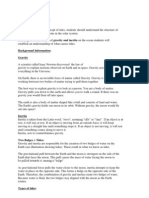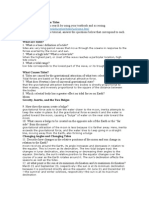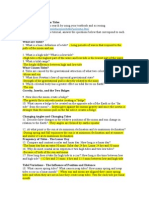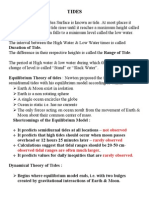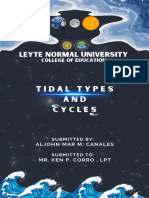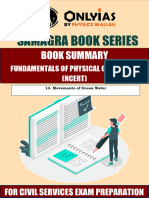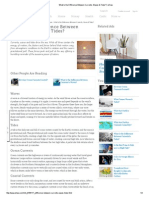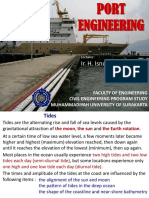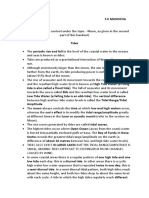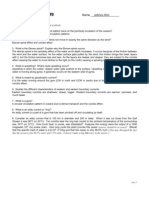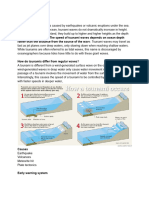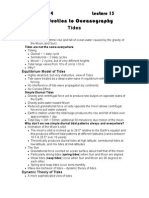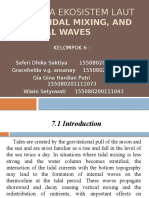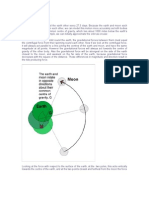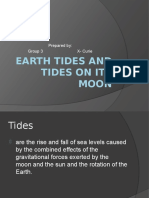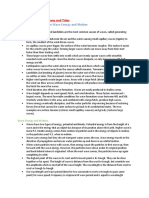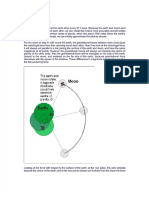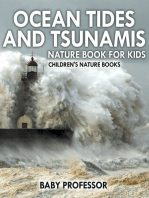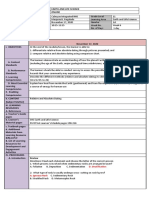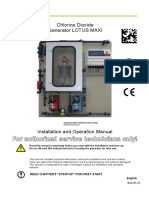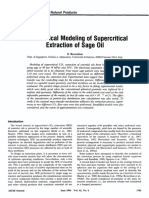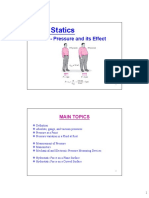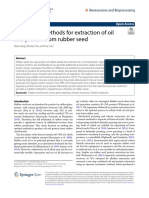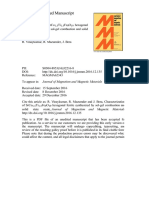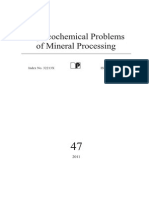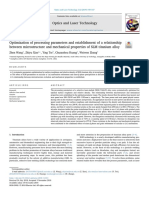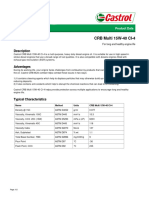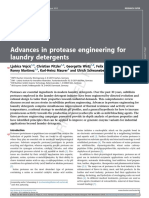0 ratings0% found this document useful (0 votes)
70 viewsTides Webquest 1
Tides Webquest 1
Uploaded by
api-264099015Copyright:
© All Rights Reserved
Available Formats
Download as DOC, PDF, TXT or read online from Scribd
Tides Webquest 1
Tides Webquest 1
Uploaded by
api-2640990150 ratings0% found this document useful (0 votes)
70 views3 pagesOriginal Title
tides webquest 1
Copyright
© © All Rights Reserved
Available Formats
DOC, PDF, TXT or read online from Scribd
Share this document
Did you find this document useful?
Is this content inappropriate?
Copyright:
© All Rights Reserved
Available Formats
Download as DOC, PDF, TXT or read online from Scribd
Download as doc, pdf, or txt
0 ratings0% found this document useful (0 votes)
70 views3 pagesTides Webquest 1
Tides Webquest 1
Uploaded by
api-264099015Copyright:
© All Rights Reserved
Available Formats
Download as DOC, PDF, TXT or read online from Scribd
Download as doc, pdf, or txt
You are on page 1of 3
Tides Webquest
Part I: Background on Tides
Begin your information search by using your textbook and accessing
http://www.nos.noaa.gov/education/tides/welcome.html
As you read through the tutorial, answer the questions below that correspond to each
section of the tutorial.
What are Tides?
1. What is a basic definition of a tide?
ides are !ery long period wa!es that correspond with the gra!itational pull of the sun
and moon.
". What is a high tide? What is a low tide?
#igh tide is when the tide is at its highest point, and low tide is when the water is at
its lowest point.
$. What is tidal range?
idal range is the length between high tide and low tide.
What Causes Tides?
%. ides are caused by the gra!itational attraction of what two celestial bodies?
he sun and the moon
&. What does 'ewton(s law of uni!ersal gra!itational state?
'ewton(s law of uni!ersal gra!itational states that any two bodies in the uni!erse
attract each other with a force that is directly proportional to the product of their
masses and in!ersely proportional to the square of distance between them.
). Which celestial body has a greater effect on tidal forces on *arth?
he moon has a stronger gra!itational pull on the *arth due to the fact that is closer.
his means that the mo!ement of the moon has a greater impact on the tides than the
sun.
Gravity, Inertia, and the Two Bulges
+. #ow does the moon create a bulge?
he moon creates a bulge in the water because of its gra!itational pull. he moon is
pulling the water towards itself, but the inertia of the water attempts to keep the water
in place. #owe!er, the gra!itational force exceeds the force of the inertia, thus
creating a bulge.
1,. What causes a bulge to be created on the opposite side of the *arth or the -far
side. from the moon?
he reason for a bulge on the opposite side of the *arth is because the moon is farther
away.
Changing ngles and Changing Tides
11. /escribe how changes in the relati!e positions of the moon and sun change in
relation to the *arth?
As the moon re!ol!es around the *arth, its angle increases and decreases around the
equator, this is called declination. he two bulges track the moon in this declination.
0imilarly, the suns relati!e position changes o!er a year as the *arth rotates re!ol!es
around it.
1". At what point is the sun at its minimum declination and its maximum declination?
1inimum2 1arch "1
st
, 0eptember "$
rd
1aximum2 3une "1
st
, /ecember ""
nd
!requency o" Tides # The $unar %ay
14. 5ompare and contrast a solar and lunar day. #ow long is a lunar day?
A solar day is the length it takes the sun to cross the two meridians. A lunar day is
"&.$ days, and is the same "&.$ days for re!ol!ing and rotating.
1%. Why do most coastal areas experience two high tides and two low tides?
his happens because of the tidal bulges.
1&. #ow long does it take for high tide to occur? #ow long is the time between low
and high tide? #igh tide2 1" hours and "4 minutes apart. 6t takes % hours and 1".4
minutes to change from high to low tide.
Tidal &ariations # The In"luence o" Position and %istance
1). What causes spring tides? What causes neap tides? #ow many spring and neap
tides occur in a lunar month? 0pring tides happen when the sun, earth, and moon are
aligned, thus create a strong gra!itational pull. 'eap tides occur when the sun, earth,
and moon form a right angle. his creates a week gra!itational pull, which in turn
causes a slight change between high and low tides. wo sets of spring and neap tides
occur in each lunar month.
1+. #ow are tide7generating forces affected when the moon is closest to the *arth 8or
perigee9, how about when the moon is farthest away from the *arth 8or apogee9? #ow
does this affect the tides that are produced?
he closer the moon is to the *arth the stronger the gra!itational pull. his means that
tides will be more intense in perigee than in apogee because the moon is pulling the
water with more force. 6n apogee, the moon has less gra!itational pull, and thus the
tides aren(t as strong.
",. #ow are tide7generating forces affected when the *arth is closest to the sun 8or
perihelion9? when the *arth is farthest from the sun 8or aphelion9? #ow does this
affect the tides that are produced?
When *arth is closest to the sun, the tides range increases dramatically, and when
*arth is farthest from the sun the opposite occurs, with the tides range lowering
dramatically. his happens because of the distance from the *arth to the sun.
What ""ects Tides in ddition to the 'un and (oon?
"1. #ow are the magnitudes of tides affected by shorelines? By mid7ocean islands?
ides near shorelines are affected minutely, the shape changes them. By mid7ocean
islands, tides barely change, with about a meter between high and low tide.
"". #ow does a funnel7shaped bay compare to a narrow inlet and shallow water?
:unnel shaped bays ha!e !ery high tides, compared to the relati!ely small tides of a
narrow inlet and shallow water.
"$. What is the affect of strong tidal ri!ers on tides in estuaries?
;owerful ri!er flows can mask the effects of tides, making it seem like they are non
existent.
"<. What other abiotic factors affect tides? 5ompare and contrast wind and weather
patterns that affect tides.
Wind and weather patterns also affect tides, as well as ri!er currents and things of that
nature. Wind can mo!e water away from the coast, gi!ing it an unplanned low tide, or
!ice !ersa. Whene!er the sky is o!ercast, tides are higher than normal.
You might also like
- Tides&CurrentsDocument4 pagesTides&CurrentsGriffin Glenn50% (12)
- Tides WebquestDocument3 pagesTides Webquestapi-264090085No ratings yet
- Tides WebquestDocument2 pagesTides Webquestapi-265544103No ratings yet
- Lesson Plan - TidesDocument6 pagesLesson Plan - TidesKavita Gupta100% (1)
- Tides WebquestDocument3 pagesTides Webquestapi-264753403No ratings yet
- Tides WebquestDocument2 pagesTides Webquestapi-264873863No ratings yet
- Tides WebquestDocument3 pagesTides Webquestapi-264756260No ratings yet
- Tides WebquestDocument3 pagesTides Webquestapi-2642205840% (2)
- Tides WebquestDocument2 pagesTides Webquestapi-264590160No ratings yet
- Tides WebquestDocument2 pagesTides Webquestapi-264220457No ratings yet
- Tides WebquestDocument2 pagesTides Webquestapi-264873508No ratings yet
- Tides WebquestDocument3 pagesTides Webquestapi-264886115No ratings yet
- Tides WebquestDocument2 pagesTides Webquestapi-265487375No ratings yet
- Tides WebquestDocument2 pagesTides Webquestapi-264150929No ratings yet
- Tides WebquestDocument2 pagesTides Webquestapi-264100173No ratings yet
- Tides: Not Observed Rarely Observed Observed Tidal Ranges Are Often Much Larger Rarely ObservedDocument17 pagesTides: Not Observed Rarely Observed Observed Tidal Ranges Are Often Much Larger Rarely Observedchuchu092010No ratings yet
- High TideDocument15 pagesHigh TideHồng LêNo ratings yet
- 5.1 Describe The Basic Theory of TidesDocument16 pages5.1 Describe The Basic Theory of TidesAley Nabi RizviNo ratings yet
- Reviewed By: John Luick: TidesDocument9 pagesReviewed By: John Luick: TidesMohan KumarNo ratings yet
- Week 11 TidesDocument36 pagesWeek 11 Tidesczedric25No ratings yet
- 4. Renewable EnergyDocument53 pages4. Renewable Energyhamza jelaniNo ratings yet
- TidesDocument67 pagesTidesmonsur ahmedNo ratings yet
- Tidal Types and CyclesDocument6 pagesTidal Types and CyclesAljohn Mar CanalesNo ratings yet
- Physics WrittenDocument18 pagesPhysics WrittenMikey IrwinNo ratings yet
- Geography (Chapter 13) - Daily Class Notes - Samagra Book Series Batch (Hinglish)Document8 pagesGeography (Chapter 13) - Daily Class Notes - Samagra Book Series Batch (Hinglish)aayushgoswami810No ratings yet
- What Is The Difference Between Currents, Waves & Tides - EHowDocument1 pageWhat Is The Difference Between Currents, Waves & Tides - EHowicemage1991No ratings yet
- Tides and Currents: Week 1 & 2Document40 pagesTides and Currents: Week 1 & 2Seth MurilloNo ratings yet
- Port Engineering-04Document27 pagesPort Engineering-04Rhezader AgNo ratings yet
- 5 TidesDocument5 pages5 TidesJonas CabacunganNo ratings yet
- Oceanography Slides SHB Chapter8Document21 pagesOceanography Slides SHB Chapter8Kogulan MuruganNo ratings yet
- TIDES Handout 2022 (Final) PDFDocument6 pagesTIDES Handout 2022 (Final) PDFArsh100% (1)
- Tide ObservationsDocument39 pagesTide ObservationsJeffpedidaNo ratings yet
- HW09, OceansDocument2 pagesHW09, Oceansjohnny_kim_10No ratings yet
- TidesDocument3 pagesTidesKeynie Densing VasayNo ratings yet
- OceanographyDocument61 pagesOceanographyAbdul skNo ratings yet
- Tidal EnergyDocument122 pagesTidal EnergySandeep Badarla50% (2)
- Navigation NAU 102 Lesson 25Document37 pagesNavigation NAU 102 Lesson 25Daniel EnglandNo ratings yet
- Lesson 4.1 Waves-OceanographyDocument10 pagesLesson 4.1 Waves-OceanographyMary Jean AmparoNo ratings yet
- 001 CombineDocument23 pages001 CombineMahmoud Magdy RizkNo ratings yet
- Basics of TidesDocument11 pagesBasics of TidesHarikrishnaNo ratings yet
- WavesTides and CurrentsDocument33 pagesWavesTides and Currentsamit kumar singhNo ratings yet
- OceanographyDocument21 pagesOceanographyOmar MianNo ratings yet
- Eas/Bioee 154 Introduction To Oceanography: TidesDocument3 pagesEas/Bioee 154 Introduction To Oceanography: TidesagungpriyantoNo ratings yet
- Dinamika Ekosistem LautDocument36 pagesDinamika Ekosistem LautAkkferiuggneko-nekomncoba Ingintuggndableqclmaeadant DmentmafbntwitNo ratings yet
- Tides Types and FormationDocument4 pagesTides Types and FormationNikhil YadavNo ratings yet
- Tides, Tidal Mixing, and Internal WavesDocument11 pagesTides, Tidal Mixing, and Internal WavesAkkferiuggneko-nekomncoba Ingintuggndableqclmaeadant DmentmafbntwitNo ratings yet
- NAV SCIENCE - Tides and Tidal StreamsDocument39 pagesNAV SCIENCE - Tides and Tidal Streamsshafiq100% (1)
- Moon (Tides and The Moon)Document21 pagesMoon (Tides and The Moon)Wael ZakNo ratings yet
- Group 5 TidesDocument23 pagesGroup 5 TidesJayson ReyNo ratings yet
- Earth Tides and Tides On Its MoonDocument34 pagesEarth Tides and Tides On Its Moondtnw27No ratings yet
- I. Introduction To Wave Energy and Motion: Chapter 4 Outline - Waves and TidesDocument4 pagesI. Introduction To Wave Energy and Motion: Chapter 4 Outline - Waves and TidesRyan SolomonNo ratings yet
- Tides and The MoonDocument21 pagesTides and The MoonCA_KenNo ratings yet
- Water Waves GLDocument4 pagesWater Waves GLnaturevideovlogNo ratings yet
- E PortfolioDocument13 pagesE Portfolioapi-303097719No ratings yet
- TidesDocument16 pagesTidespisces_sanjeevNo ratings yet
- Ovements OF Cean AterDocument6 pagesOvements OF Cean AterAjit BandgarNo ratings yet
- 22 Coastal ZonesDocument15 pages22 Coastal ZonesLuisa LouisaNo ratings yet
- Ocean Tides and Tsunamis - Nature Book for Kids | Children's Nature BooksFrom EverandOcean Tides and Tsunamis - Nature Book for Kids | Children's Nature BooksNo ratings yet
- Modeling of The Rotation Curve of GalaxiesDocument20 pagesModeling of The Rotation Curve of GalaxiesSergio HernandezNo ratings yet
- Reactors1 29Document2 pagesReactors1 29Mourad kharbachNo ratings yet
- Test - 1: (Physics)Document56 pagesTest - 1: (Physics)Chandana InguvaNo ratings yet
- Co1 Regalado 11-17-2020 Earth and Life ScienceDocument9 pagesCo1 Regalado 11-17-2020 Earth and Life ScienceMarjorie BrondoNo ratings yet
- LOTUS Maxi EngDocument88 pagesLOTUS Maxi EngThomas Gunardi SantosoNo ratings yet
- 2009 M 14 JansenDocument9 pages2009 M 14 Jansenfutsal2003No ratings yet
- Periodic Table QDocument2 pagesPeriodic Table QSaihaan.ZNo ratings yet
- Understanding Work, Heat, and The First Law of Thermodynamics 1: FundamentalsDocument40 pagesUnderstanding Work, Heat, and The First Law of Thermodynamics 1: FundamentalsHugo HernandezNo ratings yet
- Chapter3 - Science, Systems, Matter and EnergyDocument64 pagesChapter3 - Science, Systems, Matter and EnergyRetxed LeifNo ratings yet
- Mathematical Modeling of Supercritical Extraction of Sage OilDocument7 pagesMathematical Modeling of Supercritical Extraction of Sage OilDavide Di ZioNo ratings yet
- Fluid I - Lec 3 and 4 - ProductionDocument34 pagesFluid I - Lec 3 and 4 - Productionamr mohamedNo ratings yet
- Solar Radiation: Sunlight and More: Non Conventional Sources OF EnergyDocument15 pagesSolar Radiation: Sunlight and More: Non Conventional Sources OF EnergyAnutosh BhaskarNo ratings yet
- Biorefinery Methods For Extraction of Oil and Protein From Rubber SeedDocument11 pagesBiorefinery Methods For Extraction of Oil and Protein From Rubber SeedShivamNo ratings yet
- A01 SimulationDocument59 pagesA01 SimulationzvjesosNo ratings yet
- Non Local TheoryDocument12 pagesNon Local TheoryAdnan JahangirNo ratings yet
- Fluid Properties PDFDocument6 pagesFluid Properties PDFSheikh BajunaidNo ratings yet
- Author's Accepted Manuscript: Journal of Magnetism and Magnetic MaterialsDocument34 pagesAuthor's Accepted Manuscript: Journal of Magnetism and Magnetic MaterialsShahnazkartikaNo ratings yet
- NGR PanelDocument17 pagesNGR PanelnikerNo ratings yet
- CEM1008F June Exam 2019Document18 pagesCEM1008F June Exam 2019lia lightNo ratings yet
- Semester Theory Examination Second Half 2020 Question Bank Section I: Multiple Choice Question (MCQ'S)Document4 pagesSemester Theory Examination Second Half 2020 Question Bank Section I: Multiple Choice Question (MCQ'S)kiran ambadeNo ratings yet
- BS en Iso 14692-3-2017Document46 pagesBS en Iso 14692-3-2017SRIDHAR BABU KONADANo ratings yet
- Physicochemical ProblemsDocument309 pagesPhysicochemical ProblemsNataniel LinaresNo ratings yet
- Shell Saraline 185V - BrochureDocument8 pagesShell Saraline 185V - BrochureYanu Ismadi100% (2)
- 7.7 High Pressure Vapour Liquid Equilibria: V L I IDocument7 pages7.7 High Pressure Vapour Liquid Equilibria: V L I IayushNo ratings yet
- Environmental Pollution: ReviewDocument15 pagesEnvironmental Pollution: ReviewTiago TorresNo ratings yet
- 1 s2.0 S0030399218312441 MainDocument9 pages1 s2.0 S0030399218312441 MainVIRAJ PATILNo ratings yet
- Center of Mass.Document130 pagesCenter of Mass.TammanurRavi100% (1)
- Distribution of Nuclear ChargeDocument7 pagesDistribution of Nuclear Chargegellerparis10No ratings yet
- Castrol CRB Multi 15W40 CI-4 ENDocument2 pagesCastrol CRB Multi 15W40 CI-4 ENconsultas.excel.2020No ratings yet
- Thermodynamics of Surfaces and InterfacesDocument6 pagesThermodynamics of Surfaces and InterfacesVaibhav NikharNo ratings yet



